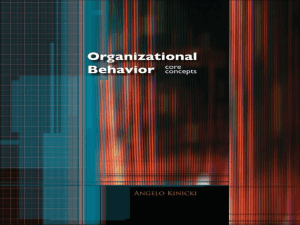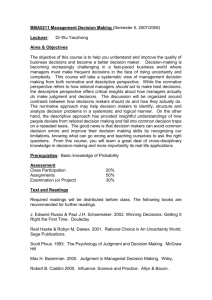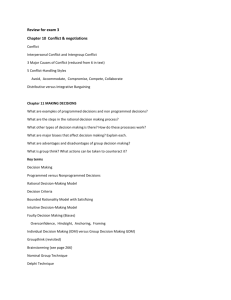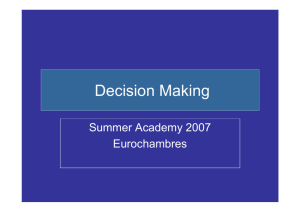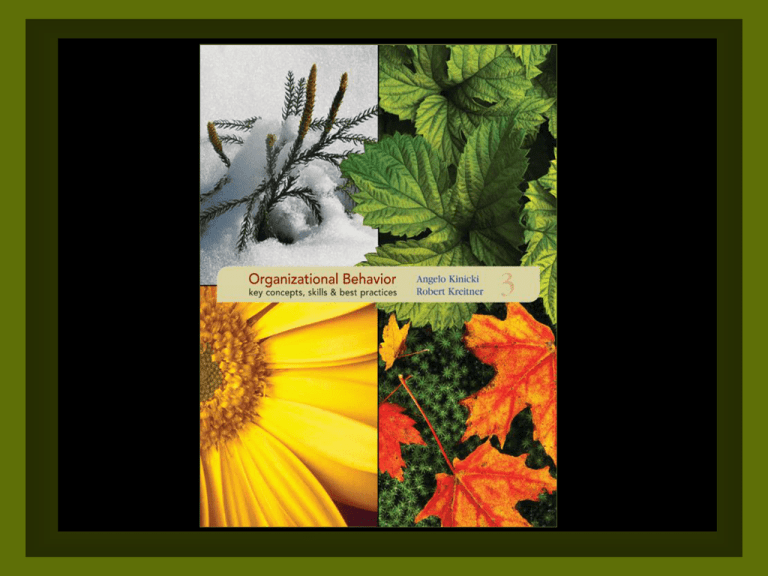
Chapter Ten
Making Decisions
McGraw-Hill/Irwin
Organizational Behavior: Key Concepts, Skills & Best Practices, 3/e
Copyright © 2008 The McGraw-Hill Companies, Inc. All rights reserved.
After reading the material in this chapter,
you should be able to:
• Compare and contrast the rational model of decision
making and Simon’s normative model.
• Discuss knowledge management techniques used by
companies to increase knowledge sharing.
• Explain the model of decision-making styles and the
stages of the creative process.
• Summarize the pros and cons of involving groups in the
decision-making process.
• Explain how participative management affects
performance.
• Contrast brainstorming, the nominal group technique, the
Delphi technique, and computer-aided decision making.
10-3
Models of Decision Making
• Decision making – identifying and
choosing solutions that lead to a desired
result
10-4
Models of Decision Making
The Rational Model - logical four-step
approach to decision making.
• Identifying the problem
• Generating alternative solutions
• Selecting a solution
• Implementing and evaluating the solution
10-5
Rational Model
• Identifying the Problem
- Problem – exists when the actual situation and
the desired situation differ
• Generating Solutions
- For routine decisions alternatives are readily
available through decision rules
10-6
Rational Model
• Selecting a Solution
- Want to maximize the expected utility of an
outcome
- People vary in their preferences for safety or
risk
- Ethics should be considered
10-7
Rational Model
• Selecting a Solution
- Evaluating alternatives assume they can be
judged according to some criteria
- Assumes valid criteria exists
- Each alternative can be compared to these
criteria
- Decision maker actually uses the criteria
10-8
Rational Model
• Implementing and Evaluating the
Solution
- After solution is implemented, the evaluation
phase is used to evaluate its effectiveness
- Optimizing – choosing the best possible
solution
10-9
Simon’s Normative Model
Decision making is characterized by:
1. Limited information processing
2. Use of judgmental heuristics
3. Satisficing
10-10
Simon’s Normative Model
Limited Information Processing
• Tendency to acquire manageable rather
than optimal amounts of information
• Difficult for managers to identify all possible
alternative solutions
10-11
Question?
What is a rule of thumb that people use to
reduce information processing
demands?
A. Decision maker
B. Judgmental heuristics
C. Judgmental verdict
D. Decision conclusion
10-12
Simon’s Normative Model
• Judgmental heuristics - rules of thumb or
shortcuts that people use to reduce
information processing demands.
10-13
Simon’s Normative Model
• Availability heuristic - tendency to base
decisions on information readily available
in memory.
• Representativeness heuristic - tendency
to assess the likelihood of an event
occurring based on impressions about
similar occurrences.
10-14
Simon’s Normative Model
• Satisficing - choosing a solution that
meets a minimum standard of acceptance
10-15
Dynamics of Decision Making
• Knowledge management - implementing
systems and practices that increase the
sharing of knowledge and information
throughout an organization
Read an
article on
Knowledge
Management
10-16
Knowledge Management
• Tacit knowledge - information gained through
experience that is difficult to express and
formalize.
• Explicit knowledge - information that can be
easily put into words and shared with others.
10-17
Decision Making Styles
• Decision making styles – combination of
how individuals perceive and respond to
information
10-18
Decision Making Styles
• Value orientation – reflects the extent to
which an individual focuses on either task
and technical concerns or people and
social concerns when making decisions
• Tolerance for ambiguity – extent to which
a person has a high need for structure or
control in his life
10-19
Decision Making Styles
Figure 10-1
10-20
Escalation of Commitment
• Escalation of
commitment sticking to an
ineffective course of
action too long
10-21
Escalation of Commitment
Psychological and Social Determinants
1. Tend to bias facts so that they support
previous decisions
2. Take more risks when a decision is
stated in negative terms
3. Get too ego-involved with the project
10-22
Escalation of Commitment
Organizational Determinants
• Breakdowns in communication
• Workplace politics
• Organizational inertia
10-23
Recommendations
To Reduce Escalation of Commitment
• Set minimum targets for performance, and
have decision makers compare their
performance with these targets.
• Have different individuals make the initial
and subsequent decisions about a project.
• Encourage decision makers to become
less ego-involved with a project.
10-24
Recommendations
To Reduce Escalation of Commitment
• Provide more frequent feedback about
project completion and costs.
• Reduce the risk or penalties of failure.
• Make decision makers aware of the costs
of persistence.
10-25
Question?
What is the process of using imagination to
develop a new process?
A. Originality
B. Innovation
C. Creativity
D. Resourcefulness
10-26
Creativity
• Creativity – process of using intelligence,
imagination, and skill to develop a new or
novel product, object, process, or thought
10-27
Creativity Innovation Killers
1. Short-term focus
2. Lack of time, resources, or staff
3. Leadership expects payoff sooner than is
realistic
4. Management incentives are not
structured to reward innovation
5. Lack of systematic innovation process
6. Belief that innovation is inherently risky
10-28
Group Involvement
• Minority dissent – extent to which group
members feel comfortable disagreeing with
other group members,
and a group’s level
of participation in
decision making
10-29
Advantages and Disadvantages of
Group-Aided Decision Making
10-30
Participative Management
• Participative Management - involving
employees in various forms of decision
making
• Setting goals
• Making decisions
• Solving problems
• Making changes in the organization
10-31
Group Problem Solving Techniques
• Consensus – presenting opinions and
gaining agreement to support a decision
• Brainstorming – process to generate a
quantity of ideas
10-32
Rules for Brainstorming
1.
2.
3.
4.
5.
6.
7.
Defer judgment
Build on the ideas of others
Encourage wild ideas
Go for quantity over quality
Be visual
Stay focused on the topic
One conversation at a time
10-33
Group Problem Solving
Techniques
• Nominal Group Technique - process to
generate ideas and evaluate solutions.
• Delphi technique - process to generate
ideas from physically dispersed experts
10-34
Group Problem Solving
Techniques
• Computer-aided decision making reduces consensus roadblocks while
collecting more information in a shorter
period of time
10-35
Computer-aided Decision Making
• Chauffeur-driven systems ask
participants to answer predetermined
questions on electronic keypads
• Group-driven meetings are conducted in
special facilities equipped with individual
workstations that are networked to each
other
10-36
Video: Creative Corp
Watch BWTV discuss
corporations’ move
from a manufacturing
economy to a creative
economy. (5:44)
10-37

